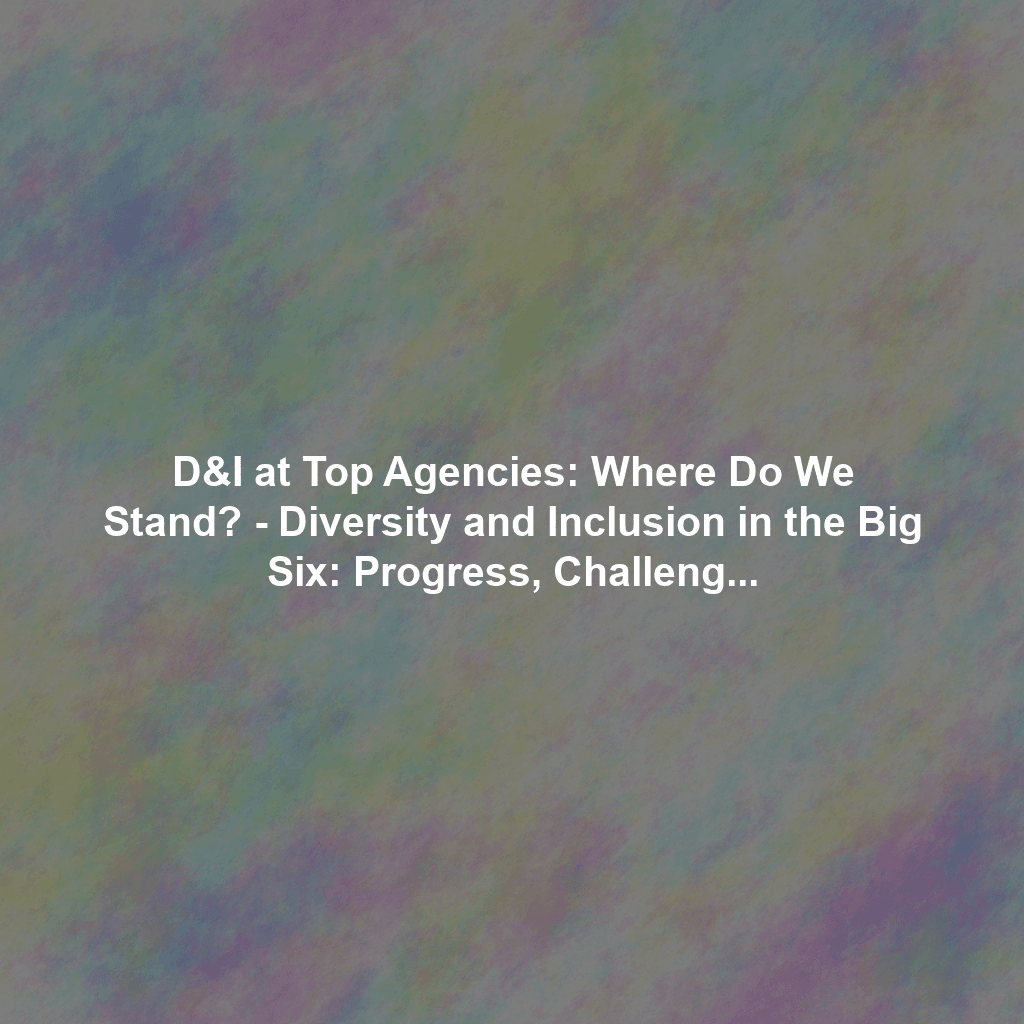The Current Landscape: Progress Made
Over the past decade, and particularly in recent years, the Big Six have demonstrably increased their focus on D&I initiatives. This has been driven by a confluence of factors, including increased societal awareness, employee activism, and client demands for more representative marketing campaigns.
Enhanced Recruitment Strategies
Many agencies have revamped their recruitment processes to attract a more diverse pool of candidates. This includes:
- Targeted outreach to Historically Black Colleges and Universities (HBCUs) and other minority-serving institutions: Actively recruiting from these institutions helps tap into talent pools that may have been previously overlooked.
- Blind resume screening: Removing identifying information from resumes can help mitigate unconscious bias in the initial screening process.
- Partnerships with diversity-focused organizations: Collaborating with organizations dedicated to promoting diversity in the workplace provides access to a wider network of qualified candidates.
Employee Resource Groups (ERGs)
ERGs have become a staple in many of the Big Six agencies. These groups provide a safe space for employees from underrepresented groups to connect, share experiences, and advocate for change. Common ERGs include groups for:
- Black employees
- LGBTQ+ employees
- Women
- People with disabilities
- Veterans
D&I Training and Education
Recognizing the importance of fostering a culture of understanding, many agencies have invested in D&I training programs for their employees. These programs often cover topics such as unconscious bias, microaggressions, and inclusive leadership.
The Ongoing Challenges: Where the Big Six Still Fall Short
Despite the progress made, significant challenges remain in creating truly diverse and inclusive workplaces within the Big Six.
Representation at Senior Levels
While diversity may be improving at entry-level positions, representation at senior leadership levels remains a major hurdle. The lack of diverse voices in decision-making positions can perpetuate systemic biases and hinder progress on D&I goals. The pipeline problem, while partially addressed with entry-level initiatives, requires a more focused approach to mentorship and sponsorship to ensure diverse talent has the opportunity to advance.
Pay Equity
Closing the gender and racial pay gap remains a critical challenge. Studies have shown that women and people of color often earn less than their white male counterparts for performing the same work. Transparency in pay structures and regular audits are crucial steps toward achieving pay equity.
Inclusivity Beyond Representation
Simply having a diverse workforce is not enough. True inclusion means creating a culture where everyone feels valued, respected, and empowered to contribute their unique perspectives. This requires addressing issues such as microaggressions, unconscious bias, and a lack of opportunities for advancement.
Addressing Tokenism and Performative Activism
It’s important for the Big Six to avoid tokenism, where individuals from underrepresented groups are brought in primarily for optics, without genuine opportunities for growth and influence. Similarly, “performative activism,” where agencies make superficial gestures of support without taking meaningful action, can be counterproductive and damage their credibility.
Future Goals: Charting a Course for Greater Equity
To truly become diverse and inclusive organizations, the Big Six must set ambitious goals and implement concrete strategies to achieve them.
Setting Measurable Targets and Tracking Progress
Agencies should establish specific, measurable, achievable, relevant, and time-bound (SMART) goals for D&I. This includes setting targets for representation at all levels of the organization and tracking progress regularly. Transparency in reporting these metrics is essential for accountability.
Investing in Sponsorship and Mentorship Programs
Sponsorship and mentorship programs can play a critical role in helping diverse talent advance within the organization. Sponsors actively advocate for their mentees’ career growth, while mentors provide guidance and support.
Creating Inclusive Leadership Development Programs
Developing inclusive leadership skills is essential for creating a culture of belonging. These programs should equip leaders with the tools and knowledge they need to effectively manage diverse teams and promote equity within their organizations.
Holding Leaders Accountable
Accountability is key to driving meaningful change. Leaders should be held accountable for meeting D&I goals and fostering inclusive work environments. This can be achieved through performance reviews, compensation incentives, and other mechanisms.
Going Beyond Compliance: Fostering a Culture of Belonging
Compliance with legal requirements is just the baseline. The goal should be to create a genuine culture of belonging where every employee feels valued, respected, and empowered to bring their whole selves to work. This requires a commitment to continuous learning, open dialogue, and a willingness to challenge the status quo.
Conclusion
The journey towards diversity and inclusion within the Big Six marketing agencies is an ongoing process. While progress has been made in areas such as recruitment and employee resource groups, significant challenges remain, particularly in representation at senior levels, pay equity, and fostering true inclusivity. By setting measurable targets, investing in leadership development, and holding leaders accountable, the Big Six can create more equitable and inclusive workplaces that reflect the diverse world they serve and drive innovation and creativity. The future of marketing depends on it. Ultimately, a more diverse and inclusive industry benefits not only employees but also clients and society as a whole, leading to more impactful and authentic marketing campaigns.
 Skip to content
Skip to content

